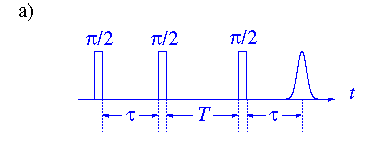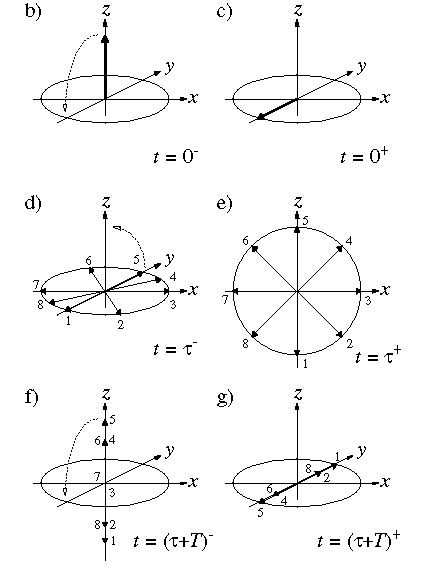Three-pulse ESEEM
The three-pulse sequence, pi/2-tau-pi/2-T-pi/2-tau-echo (Figure 1a) creates a stimulated echo at time tau after the third pi/2 pulse. The equilibrium z-magnetization (Figure 1b) is transferred to transverse magnetization by the first pi/2 pulse (Figure 1c). During free evolution of length tau, the magnetization dephases (Figure 1d). The second pi/2 pulse rotates the magnetization vectors into the xz plane (Figure 1e). During time T, the transverse magnetization decays (Figure 1f). At time t=T + tau, the third pi/2 pulse transfers the z-magnetization pattern again to transverse magnetization (Figure 1g), which forms an echo at time t = T + 2 tau along the +y-axis. The dotted curve represents the locus of the magnetization vector tips, the open arrow is the stimulated echo (Figure 1h). The stimulated echo is again an example of the "pancake-like" echo.
In a three-pulse ESEEM experiment a modulation of the stimulated-echo amplitude is observed, if time T between the second and the third pulse is increased while the time between the first and second pulse is kept constant. In contrast to the two-pulse ESEEM experiment, the three-pulse ESEEM spectra are free of sum and difference frequences [1,2]. The resolution is limited by the electron spin-lattice relaxation time T1, which is usually much larger than the electronic spin-spin lattice relaxation time T2.
References
[1] W. B. Mims, "Envelope modulation in spin echo experiments", Phys. Rev. B, 5, 2409 (1972).
[2] W. B. Mims, "Amplitudes of superhyperfine frequencies displayed in the electron spin-echo envelope", Phys. Rev. B, 6, 3543 (1972).


